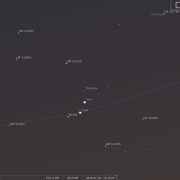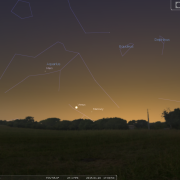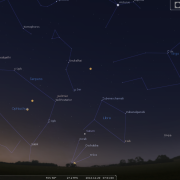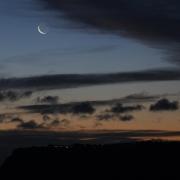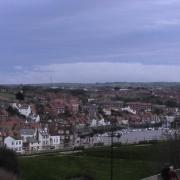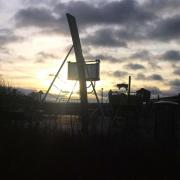In this month's Sky Notes:
Planetary Skylights
 Mars lingers in the WSW evening sky for several hours after sunset. On the 19th the red planet passes very close to Neptune when it will be just 18 arc minutes below the gas giant. You will require a telescope to spot Neptune’s tiny disk, nevertheless this will be a great opportunity to glimpse the outermost planet. Optimum time to view is between 5 and 6pm.
Mars lingers in the WSW evening sky for several hours after sunset. On the 19th the red planet passes very close to Neptune when it will be just 18 arc minutes below the gas giant. You will require a telescope to spot Neptune’s tiny disk, nevertheless this will be a great opportunity to glimpse the outermost planet. Optimum time to view is between 5 and 6pm.
.

 Mercury joins Venus in the evening twilight sky and will be visible for most of the month. The pair are closest on the 10th. Look for them 45 minutes after sunset low in the South-West. Dazzling Venus climbs almost straight up from the horizon over the course of the month, and should require no help in identifying, as long as your horizon is relatively uncluttered. Mercury follows Venus up into the sky, reaching it’s highest point by the 18th (approx 9 degrees above the horizon - thereafter it fades, arcing back down to the horizon. Mercury is brightest at the start of its apparition, so try to spot it before the 15th. The crescent moon lies nearby on the evening of the 21st and 22nd.
Mercury joins Venus in the evening twilight sky and will be visible for most of the month. The pair are closest on the 10th. Look for them 45 minutes after sunset low in the South-West. Dazzling Venus climbs almost straight up from the horizon over the course of the month, and should require no help in identifying, as long as your horizon is relatively uncluttered. Mercury follows Venus up into the sky, reaching it’s highest point by the 18th (approx 9 degrees above the horizon - thereafter it fades, arcing back down to the horizon. Mercury is brightest at the start of its apparition, so try to spot it before the 15th. The crescent moon lies nearby on the evening of the 21st and 22nd.
 Conspicuous Jupiter gradually takes centre stage as we head through January and will be well placed for observation throughout the latter part of the evening dominating the eastern aspect of the sky from 8pm onwards. By midnight Jupiter lies almost due south residing just ahead of the ‘sickle asterism’ in Leo, not far from Regulus, its chief star. Viewed through a telescope Jupiter is a wonderful spectacle with its attendant major moons and 'banded' disk, definitely a ‘must see’ object. The moon lies nearby on the 7th.
Conspicuous Jupiter gradually takes centre stage as we head through January and will be well placed for observation throughout the latter part of the evening dominating the eastern aspect of the sky from 8pm onwards. By midnight Jupiter lies almost due south residing just ahead of the ‘sickle asterism’ in Leo, not far from Regulus, its chief star. Viewed through a telescope Jupiter is a wonderful spectacle with its attendant major moons and 'banded' disk, definitely a ‘must see’ object. The moon lies nearby on the 7th.
Looking South: Saturn
close to Crescent Moon on
16-January at 06:45h
(Click image for full-size view)
 Saturn is visible in the early morning sky low to the SE by 6am, although wait until 7am before attempting telescopic observations. A lovely waning crescent moon lies close by on the 16th.
Saturn is visible in the early morning sky low to the SE by 6am, although wait until 7am before attempting telescopic observations. A lovely waning crescent moon lies close by on the 16th.
 Earth reaches Perihelion (closest to the Sun) some 91.4 million miles or 147 million km. on Jan 4th at 07:00h GMT.
Earth reaches Perihelion (closest to the Sun) some 91.4 million miles or 147 million km. on Jan 4th at 07:00h GMT.
Meteor Activity

The New year starts with one of the more prolific meteor showers, the Quadrantids, active between Jan 1st-6th . The shower’s short lived peak normally falls in the early hours of the 4th, around 02:00-04:00h, which along with weather constraints is the main reason it is poorly observed. In favourable observing conditions zenith hourly rates can exceed 100 in the early morning hours, however the moon will be nearly full this time round, drowning out many fainter shooting stars, so expect actual observed rates to be 12-20 per hour.
Quadrantids appear to radiate from the now defunct constellation of Quadrans Muralis, which was removed from sky charts in 1922, but used to lie at the junction between Hercules, Bootes and Ursa Major
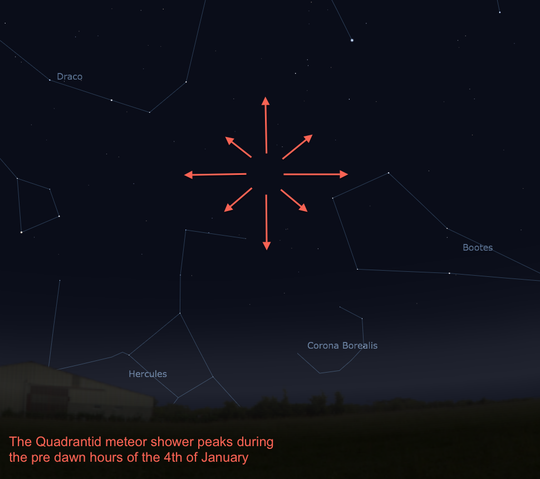
The Winter Solstice
The Sun reached its lowest position in the sky on December 21st this year and we asked for your Solstice photos for the website. As it turned out, sun was particularly scarce that day, but with a day's leeway either way, here are some Solstice photos.
January 2015 Sky Charts
Click each image to see a full-size Sky Chart:
 |
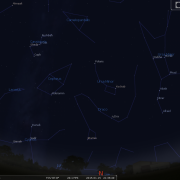 |
| Looking South Mid January - 21:30h |
Looking North |
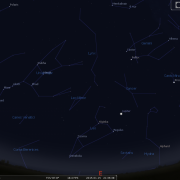 |
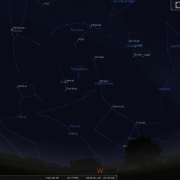 |
| Looking East Mid January - 21:30h |
Looking West Mid January - 21:30h |
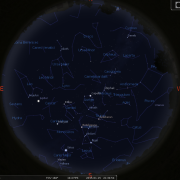 |
|
| Overview Mid-January - 21:30h |
Image Credits:
- Planets and Comets where not otherwise mentioned: NASA
- Sky Charts: Stellarium Software
- Log in to post comments

